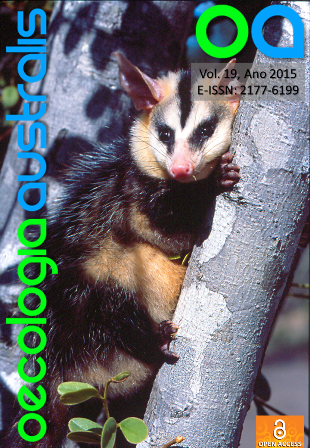INTER AND INTRASPECIFIC DIFFERENCES IN FOOD RESOURCES SELECTION AND USE IN CAPTIVE PHILANDER FRENATUS AND DIDELPHIS AURITA (DIDELPHIMORPHIA; DIDELPHIDAE)
DOI:
https://doi.org/10.4257/oeco.2015.1901.07Palavras-chave:
Diet overlap, Feeding ecology, Food habits, Food preference, OpossumsResumo
The opossums Philander frenatus and Didelphis aurita are sympatric throughout most of their distribution ranges and share several ecological traits, including natural diet. However, experimental studies on feeding habits of didelphid marsupials in captivity have revealed important differences between the nutritional contents of their diets, based on experimental food choice. Our aim was to assess inter and intraspecific differences in the diets of the two species. We hypothesized that comparisons of inter and intraspecific food habits variations in captivity can provide insights to understand the effects of differential use of food resources on niche differentiation and diversification. Thus, weused a cafeteria test with 26 different kind of foods. Food selection and use by the two specieswere analyzed and calculated niche breadth (Czekanowski's Proportional Similarity - PS index) and overlap (Pianka's index). Both P. frenatus and D. aurita had similar diets between sexes and age classes. However, D. aurita specimens used or tried a broader range of resources than those of P. frenatus for all compared categories. In P. frenatus males had a more generalist diet than females. Adults of this species were more generalist than younger specimens, and juveniles and subadults had similar indexes. In D. aurita the preferred diet was also very similar across sexes and age classes. In this species, males have a narrower diet than females. In juveniles niche breadth and diet amplitude were superior to those of subadults, while adults had the highest indexes of all three age classes. There was a high dietary overlap in all intraspecific, and interspecific comparisons performed. Our results show that selection and use of food resources in field and in laboratory coincided and are complementary, but intraspecific analysis revealed different strategies of food use in each species, which in nature may influence in niche partitioning and affect trophic structure in mammal communities.Downloads
Arquivos adicionais
- camiladebarros, Fig 1 A-E.pdf
- camiladebarros, Fig 2 A-E.pdf
- camiladebarros, Appendix I.docx
- camiladebarros, 961-5883-1-SP mod nat.docx
- camiladebarros, Indicação de revisores.docx
- camiladebarros, Answers to the referees (2).docx
- camiladebarros, Figure 1 A C.tif
- camiladebarros, Figure 1 D E.tif
- camiladebarros, Figure 2 A C.tif
- camiladebarros, Figure 2 D E.tif
- camiladebarros, 961-6501-2-ED Fig 1.pdf
- camiladebarros, 961-6501-3-ED Fig 2.pdf
- camiladebarros, 961-6501-4-ED.docx
Publicado
2017-02-23
Edição
Seção
Artigos


